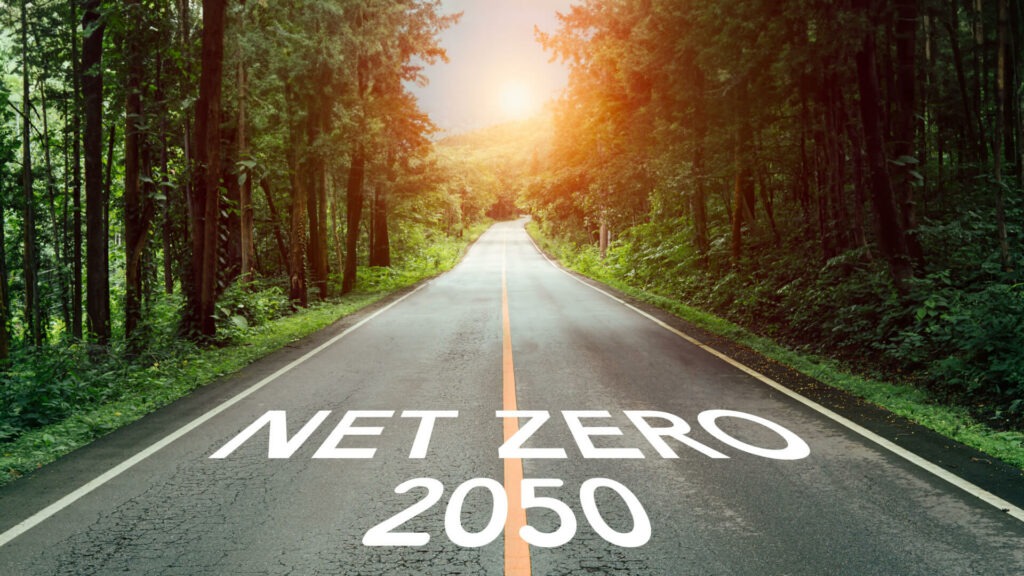Climate change is one of the most serious issues in modern times and carbon reduction has become a common goal of countries and corporations so as to keep the temperature rise within 1.5℃, which goes in tandem with carbon budgets, carbon neutrality, to the latest goal of net zero by 2050. What does net zero, which directly impact the economy, mean? This article will define net zero and address its importance to humanity and corporations along with case studies for corporations to better work towards net zero.
What is net zero?
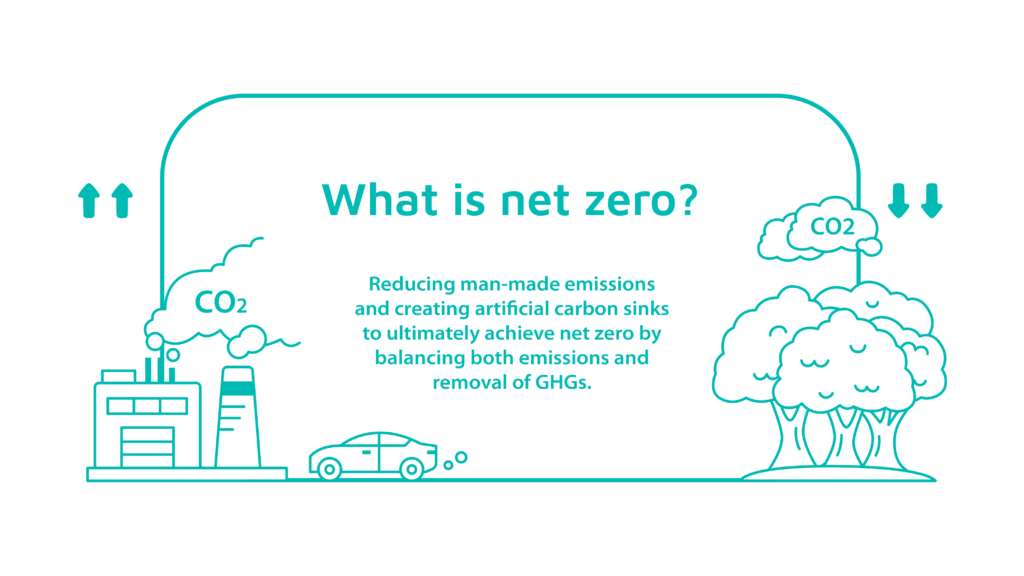
According to the IPCC, to keep the global temperature rise at 1.5℃, the remaining carbon budget (the remaining emission cap for humanity) stands at only 500 gigatons remaining. The carbon emission in 2019 was 59±6.6 gigatons CO2, and carbon emissions are increasing every year; this means that if all remains constant, the carbon budget will be exceeded within 10 years.
To meet the carbon budget, the IPCC has proposed that GHG emissions must be reduced by 45% by 2030, and net zero must be achieved by 2050. This means that humanity’s total GHG emission is equal to the artificially created carbon sink. Greenhous gases include CO2, CH4, FCs, etc. Carbon sinks are systems where CO2 absorptions higher than their carbon emissions, and examples of carbon sinks include forests, soil, and oceans. To achieve net zero, we must work towards two goals: reducing man-made emissions and creating artificial carbon sinks to ultimately achieve net zero by balancing both emissions and removal of GHGs.
Why is net zero important?
The IPCC has pointed out that the average temperature between 2006-2015 is 0.87°C higher than that between 1850-1990, meaning artificial greenhouse gases have greatly increased the temperature by 0.2°C per decade.
The global temperature rise leads to rising sea levels, extreme temperatures, and the increase of the frequency and intensity of rainfalls and droughts. For example, in 2022, Europe had the hottest June to August in history, with resulting heat and wildfires causing more than a thousand deaths. The U.S. also had the coldest Christmas eve in 40 years with a storm that caused more than 50 deaths. Controlling greenhouse gas emissions, therefore, has become an urgent issue.
To prevent climate change inflicting catastrophic impact on humanity, the IPCC proposed a plan to control the temperature rise to 1.5-2°C since the Industrial Revolution. To keep the temperature rise at 1.5°C, global greenhouse gas emissions must be reduced by 45% by 2030 and net zero must be achieve before 2050.
Global Government Net Zero by 2050 Measures
Supply chain demand
In response to the trend in carbon reduction, many corporations around the world have announced their carbon reduction targets, joined the RE100 organization, which is the global corporate committed to 100% renewable electricity, and completely adopted green energy.
For example, Apple has achieved operation carbon neutrality in 2020 and promised to do so with its global supply chain by 2030 while demanding its partners to be accountable about their progress towards the goal. According to a press release on Apple’s official website, by October of 2022, more than 200 suppliers have promised to adopt green energy for all Apple-related production activities, which consists of over 70% of Apple’s manufacturing costs. If a corporation is part of a larger corporation’s supply chain, not working towards net zero translates into possible business opportunities lost.
Carbon tax imposition for export to other countries
The Council of the European Union and the European Parliament reached an agreement on the Carbon Border Adjustment Mechanism (CBAM) on December 13, 2022. They plan to require that specific industries (including the steel, the cement and the chemical fertilizers industries) disclose their carbon emissions from October 2023. This will be fully implemented after a 3-year transitional period in 2026 when the scope of the industries covered will be expanded. The US, on the other hand, drew up the Clean Competition Act (CCA) in July 2022. If the draft is officially legislated, it will be enforced in 2024 without a transitional period. If a company has an overseas market, they have to implement net zero to avoid large tax payments and losing competitiveness.
How to prevent climate change: learn about the carbon cycle & carbon sink
What is carbon cycle?
The atmospheric level of GHGs is always fluctuating. The fluctuation in the amount of CO2 in the air is called the carbon cycle. The photosynthesis of plants, which can convert CO2 into carbohydrates (a source of food for most beings), is one of the main methods for the reduction of atmospheric CO2, while animal and plant respiration, volcano eruptions, and fossil fuel burning are sources of atmospheric CO2. The reduction and increase of CO2 facilitates the carbon cycle, but humans have been burning petrochemicals, developing forests and wetlands, and polluting the environment, which has resulted in more carbon emissions as well as smaller carbon sinks. With the carbon cycle out of balance, the concentration of CO2 in the atmosphere has risen, further causing the greenhouse effect and climate change.
What is a carbon sink?
Carbon sinks are systems that absorb more carbon from the atmosphere than is release in a specific period. For example, forests, wetlands, and the ocean are all common carbon sinks; the carbon stored in land sequestration is called green carbon, while that in the ocean is called blue carbon; and the artificial carbon sinks are the ones that store captured atmospheric CO2 in the Earth’s crust.
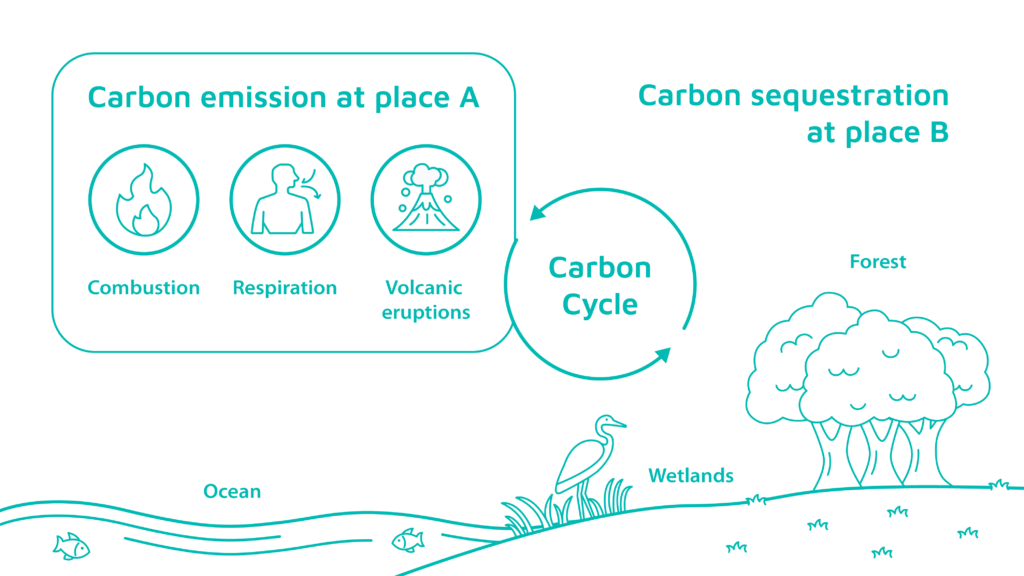
How to protect natural carbon sinks?
Let’s have a look at how the main natural carbon sinks (wetlands, forests, and the ocean) build themselves up and how great their influences are:
- Wetlands
Wetlands have the highest carbon storage in a specific area among all carbon sinks. Their wet and anaerobic environment slows down the decomposition of organisms and eventually causes deposition of substances, “sequestering” carbon in them.
- Forest
According to the statistics presented in “The Terrestrial Carbon Sink” in Annual Review of Environment and Resources, plants absorbed one-fifth of the atmospheric CO2 every year from 2007 to 2016. This means that forests, having thick vegetation, can perform photosynthesis and act as a stable source of carbon sinks.
- Ocean
The UN’s data indicates that the ocean absorbs one-fourth of the total produced CO2 annually. In the ocean, not only algae but also plankton with chloroplasts can perform photosynthesis. Meanwhile, the CO2 in the air dissolves promptly into the ocean and produces carbonic acid (H2CO3), which quickly breaks down into hydrogen (H+) and bicarbonate (HCO3+) ions. Then, the abundant coccolithophores in the ocean absorb calcium bicarbonate and convert it into calcium carbonate (CaCO3) scales. Eventually, CO2 will become coccoliths and sink to the bottom of the ocean, where it is sequestered in sediment.
Any kind of natural carbon sink is of great help when it comes to climate change prevention. Hence, actions need to be taken to help protect these natural carbon sinks, such as decreasing the exploitation of forests and wetlands and increasing artificial afforestation. Ocean pollution is also a material issue. If a massive amount of trash enters the ocean, the area in which it absorbs sunlight and touches the air is reduced, causing the decline in the amount and number of the marine vegetation and creatures. This will further lead to the decrease in the carbon sinks that can be formed every year.
Is net zero the same as carbon neutral?
Net zero is defined as the balance between the total GHG emissions and the carbon sinks. From the perspective of a corporation, it means the total GHG produced during the operation deducting the carbon sinks built by the corporation equals zero. Currently, the carbon sinks of corporations mainly come from carbon offsets, which can be obtained by establishing clean energy such as wind power, and taking carbon reduction actions such as afforestation programs in developing regions. As for carbon neutral, this refers to the balance between CO2 emissions and carbon sinks; no other GHGs such as methane need to be taken into consideration.
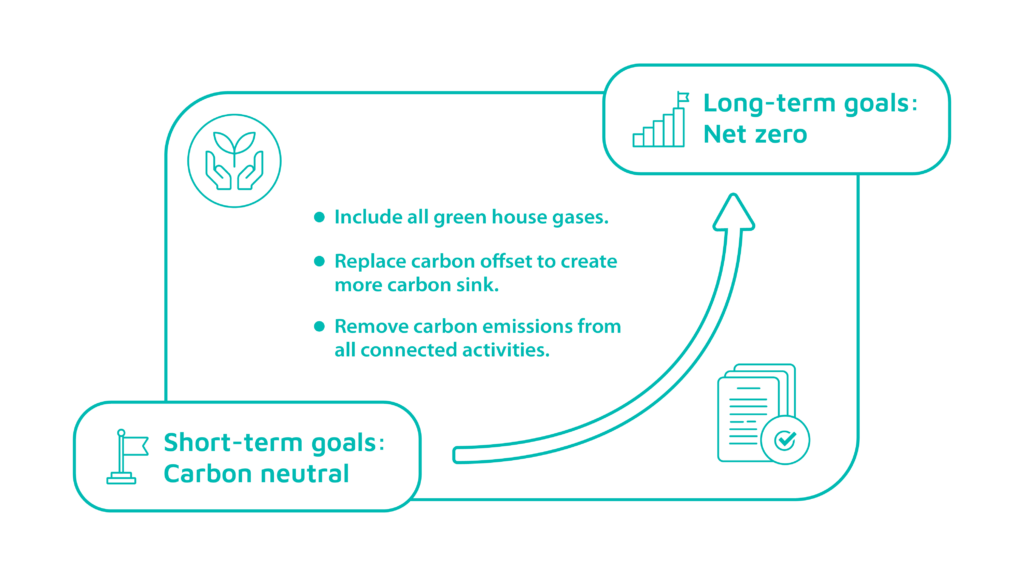
Why start with carbon neutrality?
Net zero demands all GHG emissions to be equal to the absorptions of carbon sinks, which is rather difficult to achieve. Carbon neutrality goals are relatively easier to achieve and has become a short- or mid-term target for corporations when setting their net zero goals. Corporations can start with a single activity or product and work towards the net zero global consensus by 2050.
How to do carbon neutral?
Carbon neutrality requires carbon credits, which are carbon reductions from afforestation, ecological restoration, and both solar and green energy. These projects will be certified and calculated by certain companies, which will issue certificates of carbon credits for corporations to offset emissions they cannot reduce in order to achieve carbon neutrality.
Corporates may start with verifying their carbon footprints. The ISO 14064 and ISO 10467 standards are both international standards for verifying carbon footprints. The verification is divided into three scopes, which can be used to verify a corporation’s direct and indirect carbon emissions from every procedure. After verification, one can find ways to reduce emissions, such as employing energy-saving equipment and electric vehicles, reducing packaging, using recycled materials, etc. One can manage energy use through the ISO 50001 standard and eventually purchase carbon credits approved by the PAS2060 to achieve net zero scientifically.
Carbon credits are from Voluntary Carbon Markets (VCM) , the carbon credit providers that are widely recognized include the VCS, the CAR and the GS. Corporations may choose the providers’ projects according to their contents and prices.
How to get net zero right: The 7 attributes
In the process of marching towards net zero, corporations have to pay attention to many things to optimize the outcome. Referencing to “The meaning of net zero and how to get it right” published in the scientific journal Nature Climate Change by Oxford University in December 2021, the 7 items corporations should pay attention to in order to successfully reach net zero are listed below:
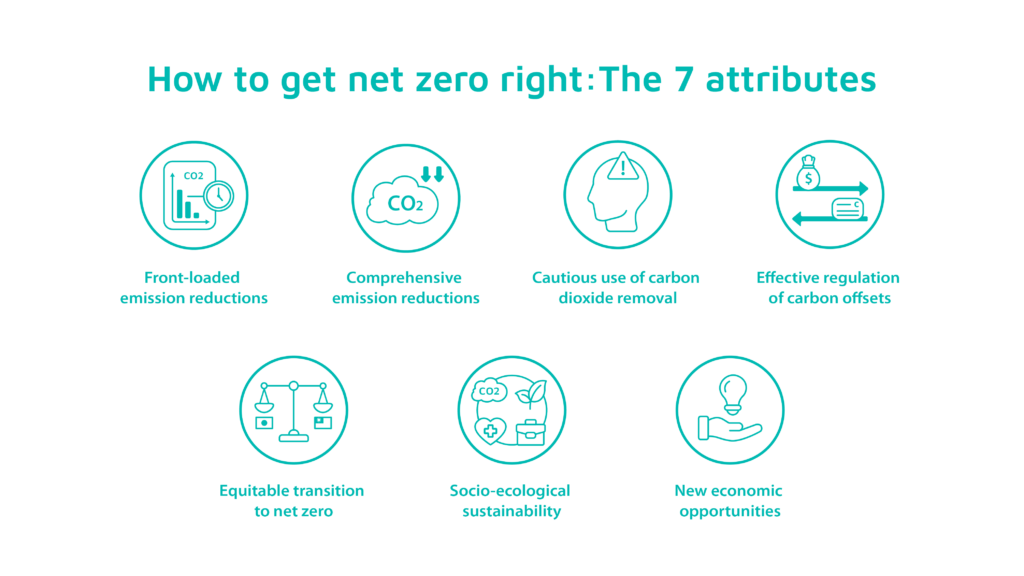
1. Front-loaded emission reductions
The IPCC has identified over 200 pathways for carbon emission reduction to reach net zero. The short-, mid- and long-term goals for carbon reduction in these pathways vary, but corporations should make effort and choose to reduce carbon drastically in the short-term rather than increasing their effort when they have already entered the middle and later stages, because it is still unclear if the change in global temperature is reversible, and the GHGs accumulated in previous periods will cause a consistent temperature rise. Research has demonstrated that every year’s delay before initiating emission reductions decreases the remaining time available to reach net zero emissions while keeping below 1.5°C by approximately two years.
In addition, the IPCC calculated the carbon reduction pathways based on the current environmental conditions. Thus, if climate change in the future gives rise to forest fires, ocean acidification (which has an impact on marine ecosystems), and other factors that result in carbon sinks dying out and a drop in carbon budgets, then the lack of appropriate carbon reduction in the early period lead to a loss of flexibility in responding to the issues.
2. Comprehensive emission reductions
In contrast to net zero, the core difference in carbon neutral is its comprehensive assessment of GHG emissions. Actions for it are thus not limited to the increase of clean energy usage, but also include air conditioners, engines, garbage disposal methods, and all behaviors that may possibly produce GHGs. This requires the joint effort of all industries, including those with difficulties in reducing carbon, e.g. the heavy, architecture, agriculture, airline and mining industries. The original low-carbon industries are also required to take actions other than their own carbon reduction. For instance, banks can provide premium green loans or green investment schemes.
3. Cautious use of carbon dioxide removal
Though humans are now investing in and doing research on direct air carbon capture and storage (DACCS) technology—capturing atmospheric CO2 and storing it in the ground—we cannot forecast what impact it could have on the environment in the long term after sending a great amount of CO2 into the strata. Moreover, afforestation can be easily affected by accidents such as floods and fires, leading to lower results than expected. Hence, reducing carbon emissions from the source is the highest priority. CO2 removal methods should only be taken (and in a cautious manner) once we have entered the stage when carbon reduction is no longer practicable.
4. Effective regulation of carbon offsets
Currently, carbon credits are provided by multiple independent organizations with different schemes and calculation methods, making them lack standardized monitoring mechanisms. As a result, many plans are not appropriately designed and the externalities derived from the execution of the plans are not comprehensively considered while the number of carbon credits is also over estimated. In the future, we expect all national governments and standard verification institutions to propose comprehensive and expanded review methods. At the current stage, corporations may learn more about the content of each carbon offset scheme in terms of practices to ensure that the money spent on purchasing carbon credits is actually invested in climate actions with sufficient strength.
5. Equitable transition to net zero
Many wealthy countries today have gone through a process of highly-polluting, low-cost development. However, if they treat countries with developing economies equally during the process of net zero, they may cause inequality between the countries as well as poverty while protecting the environment. Thus, separate net zero pathways designed according to contexts of countries are needed. The investments in these resource-poor countries, the introduction of clean energy and the low-polluting development are also a source of some of the carbon credits. Hence, corporations may purchase relevant carbon credits or establish low-carbon business models in developing countries.
6. Socio-ecological sustainability
Today, climate change is the most urgent issue to be solved, but other environmental and social aspects need to be taken into consideration while mitigating global warming. For example, farmers should not be deprived of their agricultural lands for the purpose of planting non-native trees; this behavior may affect the residents’ livelihoods and even destroy the ecosystems. A better way would be gathering local residents, governments, and interest groups together to make detailed investigations and provide the people affected with proper compensations or other suitable job opportunities. The recovery of the original ecosystems should also be a priority in order to avoid causing other social issues in the name of carbon reduction. Carbon credit schemes that cover aspects in an all-around manner are available for corporations to choose, such as the Gold Standard which takes gender equality, diversity and inclusion into consideration and requires making contributions to 3 or more SDG indicators.
7. New economic opportunities
Many people believe that net zero will harm national economies and corporate profits as achieving it is an arduous process, including the procurement of industrial facilities and transformation. Nonetheless, from a national perspective, reducing the compensation for high-polluting industries (e.g. petrochemical fuel) can help develop other new and alternative industries (e.g. solar and wind power and energy storage) and create a new economic mode that is low-polluting and with high added value. On the other hand, if the corporations are able to take the lead in reducing carbon, they will have more advantages in competing with their peers as well as attracting more consumers, funds and talent.
Conclusion
Carbon reduction isn’t a battle for corporations to fight alone. Various countries support net zero policies. For example, in the act signed by the US President in 2022, US$370 billion is budgeted for carbon reduction and green technology promotion, including tax reduction for clean energy production, pollution reduction, and encouraging consumers to purchase appliances and heat pumps to improve household energy efficiency. This means that companies in these industries may improve competitiveness in terms of prices and thus lower the cost for corporations to employ energy-saving equipment and green energy for carbon neutrality. If corporations can comply with government policies, their paths to net zero may be smoother.
Moreover, many corporations have formed alliances to promote net zero. For example, the RE100, which has announced replacing fossil fuel with 100% green energy, consists of international corporations such as Apple, Amazon, Microsoft, Google, etc. There is also the French R20 Paris, which initiates net zero activities in the educational, economic, and ecological spheres. These are all organizations corporations may consider signing and joining. In them, corporations can discuss carbon reduction progress and encourage each other as they work towards the goal of net zero.













